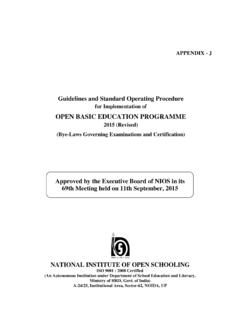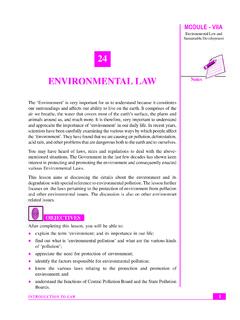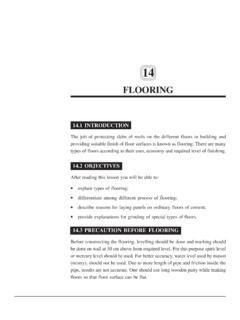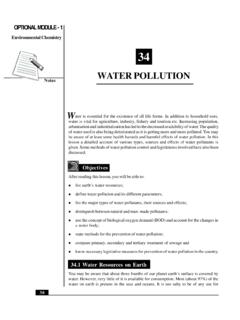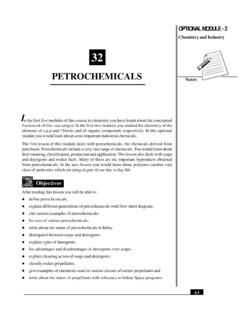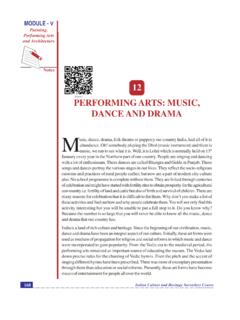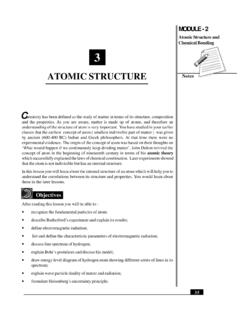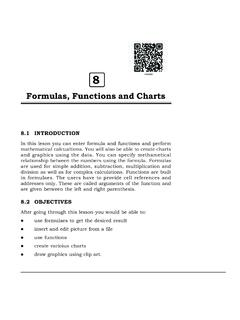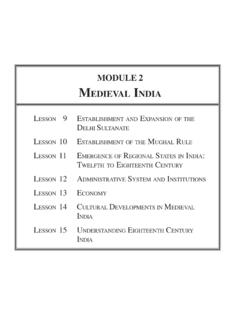Transcription of SHOOT SYSTEM - National Institute of Open Schooling
1 SHOOT SystemBIOLOGY 156 NotesMODULE - 2 Forms and Functions ofPlants and animals7 SHOOT SYSTEMS hoot SYSTEM is an aerial and erect part of plant body which grows upwards. It isusually above the soil and develops from plumule of the embryo. It consists of stem,branches, leaves, flowers, fruits and seeds. In this lesson you will study about thestructure, types, modifications and functions of stem, leaf, flower and studying this lesson, you will be able to -zlist the general characteristics of stems and distinguish them from those of root;zdescribe the SHOOT apex and explain the origin of lateral branches;zexplain the types, modifications and functions of stem;zdescribe the primary structure of dicot and monocot stems with the help ofdiagrams and distinguish between them;zdescribe secondary growth in a dicot stem;zdefine wood and its types;zdescribe the general morphology of leaf and explain phyllotaxy.
2 Zdescribe and illustrate various modifications of leaf highlighting their functions;zdescribe and compare the internal structure of a typical dicot and monocot leaf;zdefine inflorescence and describe it s major types;zdefine a flower and describe it s structure and functions;zdefine placentation and describe different kinds of placentation;zdefine and explain the structure of fruit and enlist it s major categories SYSTEM 157 BIOLOGYN otesMODULE - 2 Forms and Functions ofPlants and Characteristics of Stem(i) Arises as a prolongation of plumule (one end of an embryo).(ii)Grows and bends towards light (positively phototropic) and away from gravity(negatively geotropic).
3 (iii)Divided into nodes (point of attachment of leaf) and internodes (regionsbetween two nodes).(iv)Bears leaves, branches and flowers on nodes.(v) Bears vegetative buds which could be terminal (apical bud) for plant to growupwards or axillary (bud in the axil of leaf) which give rise to lateral branches.(vi)Bears floral buds (terminal or axillary) that grow into Differences between stem and rootTable gives the difference in morphology between stem and Morphological differences between stem and rootStemRoot1. Develops from from Young stem is greenNon green because chlorophyll is of Divided into nodes and divided into nodes and Bears leaves, vegetative and No cap present at the cap is present at the Positively phototropic and negativelyNegatively phototropic but Origin of lateral branches is exogenousOrigin of lateral roots is endogenous(originating from outer layers endodermis).
4 (originating from inner layers pericycle).INTEXT QUESTIONS Name the part of plant which bears nodes, leaves and Lateral branch develops from which bud?..3. Why is it difficult to break lateral roots and not lateral branches on stem?..4. Roots are negatively phototropic and positively geotropic, what pattern ofgrowth does the stem show?.. SHOOT SystemBIOLOGY 158 NotesMODULE - 2 Forms and Functions ofPlants and The SHOOT ApexShoot apex is the terminal, dome shaped part of SHOOT , formed of meristem calledapical SHOOT meristem responsible for the development and differentiation ofprimary permanent tissue and mainly causes growth in length. It is divided into tworegions - Tunica and Corpus (Fig.)
5 (a)(b) a-b of SHOOT apex to show tunica and corpus(i)Tunica (covering)- An outer zone of SHOOT apex, 1-3 layers in thickness. It givesrise to epidermis and is responsible for surface growth, and its cells divide onlyanticlinally.(ii)Corpus (body)- Inner multi-layered zone of cells which divide in all finally give rise to procambium (forms vascular tissue) and groundmeristem (forms ground tissue). These cells also form leaf primordia (a newlydeveloping leaf). Origin of Lateral branchesBranches arise from axillary buds present in the axil of leaves (Fig ). Each axillarybud is a small, compact, underdeveloped SHOOT covered with a large number ofoverlapping leaf primordia. Internodes of this bud enlarge and develop into a the development of branches is exogenous (exo = outside).
6 INTEXT QUESTIONS Name the meristematic zone in which cells divide in all From which meristematic layer does the vascular tissue develops?..3. Which structure gives rise to a lateral branch? Name the type of its What is the structure known as which covers the apical meristem of root butis absent in stem?..TunicaCorpusShoot SYSTEM 159 BIOLOGYN otesMODULE - 2 Forms and Functions ofPlants and Types of stemThe stem may be (i) aerial (erect, rigid, strong and upright as in herbs, shrubs andtrees) (ii) sub aerial (weak, unable to stay upright and trail on ground as creepersor climb up as climbers) or (iii) underground (buried in soil and produces aerialbranches under favourable conditions only).
7 Modifications of StemStems are variously modified into underground, sub aerial and aerial stems forperforming functions like manufacturing and storing food, perennation (overcomingunfavourable climatic conditions), providing mechanical support and protection andfor propagating vegetativelyTypes of stem and modificationsUndergroundSubaerialAerialR hizomeRunnerTendrilsCormStolonThornsBulb OffsetPhyllocladeTuberSuckerCladodeUnder ground modified stems Since underground, they may seem like roots butyou can recognise them as stem due to the presence of :(i) Nodes and internodes, (ii) scaly non green leaves, (iii) serve two functions -zAct as perennating structures by remaining leafless and dormant in winter butgiving off aerial shoots under favourable conditions (next season)zStore food and become thick and various types of underground modified stems are given in Table Underground Modified StemsTypeCharactersExamples 1.
8 RhizomeGinger (Adrak)( )Turmeric ( haldi ) 2. CormSaffron ( kesar )( )Yam ( zimikand )GladiolusThick, fleshy, flattenedhorizontally growing stem nearthe soil surface. Bears scaleleaves on nodes, terminal andaxillary buds, adventitious , spherical stem withflattened base, grows vertically;bears many scale leaves, distinctnodes and internodes, buds andadventitious SystemBIOLOGY 160 NotesMODULE - 2 Forms and Functions ofPlants and animals 3. BulbOnion( ,ii) 4. TuberPotato( )(a)(b)(c-i)(c-ii)(d) Underground modifications of stem (a) Rhizome of Ginger, (b) Corm of Yam, (ci)Bulb of Onion (cii) bulb, (d) Tuber of aerial modifications Of stem- Stems are weak, therefore lie prostrate on theground or may get partially buried in the top soil.
9 The plants bearing such stemsare called creepers. Their stems serve the function of vegetative Modifications of Sub aerial , weak, slender branch with long , Oxalis( )Runs horizontally on soil surface giving offadventitious roots at lateral branch which grows upwards thenMint ( Pudina ),(Fig. )arches down to meet the soil, strike roots andJasmineproduce daughter runner but thicker and shorter, grow for aWater hyacinth,( )short distance then produce cluster (rosette) ofwater lettuceleaves above and adventitious roots below;generally in aquatic runner which grows horizontallyChrysanthemum( )for a distance under soil then emerges obliquelyupwards, strikes roots and forms daughter plantsReduced, flattened discoid stemwith crowded nodes bearingoverlapping fleshy (inner) anddry (outer) scale leaves.
10 Terminalbud (in centre) forms foliage(green) leaves. Adventitiousroots grow from discoid tips of undergroundlateral branches of stem, storefood as starch, bear eyes . Eacheye is a node which bears budand scar of scale leafNodesAdventitiousRootScale BaseScale leafAdventitiousRootBulbCormBase of ScaleFleshyScale LeafApexAdventitiousRootEyeShoot SYSTEM 161 BIOLOGYN otesMODULE - 2 Forms and Functions ofPlants and animals(a)(b)(c)(d) Sub-aerial modification of stem : (a) Runner; (b) Stolon;(c) Offset; (d) stem modifications - Whole stem or its part (axillary or terminal bud) getsmodified to perform definite functions. You can recognise them as stems byfollowing features :(i) Arise in the axil of leaf (ii) Bear nodes and internodes (iii) may bear leaves, buds, Types of aerial stem modificationsTypeCharactersExamples1.
